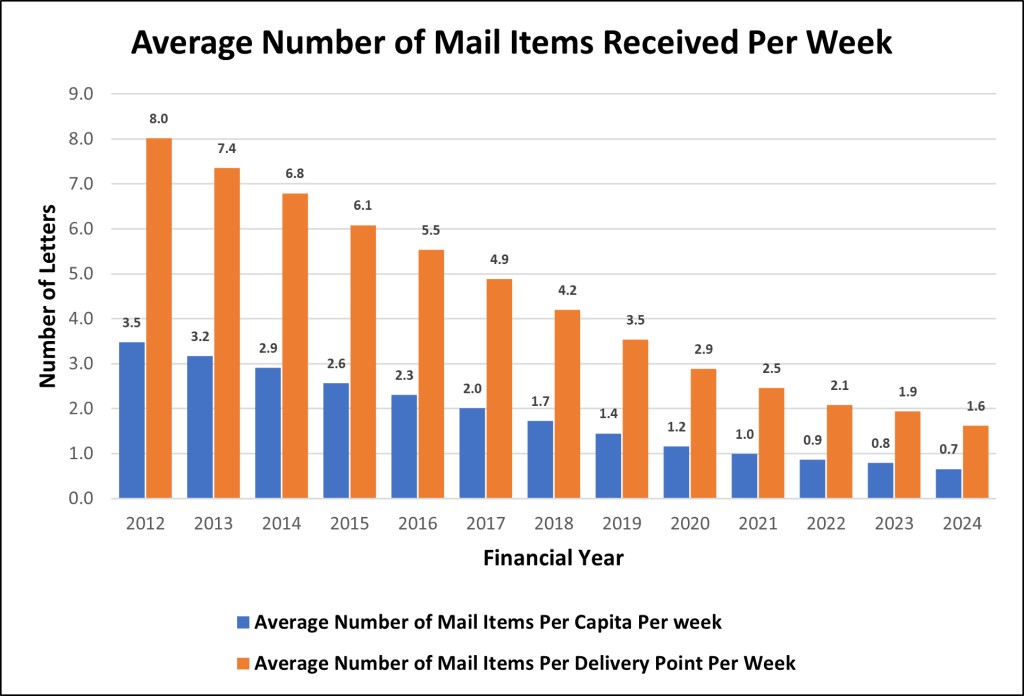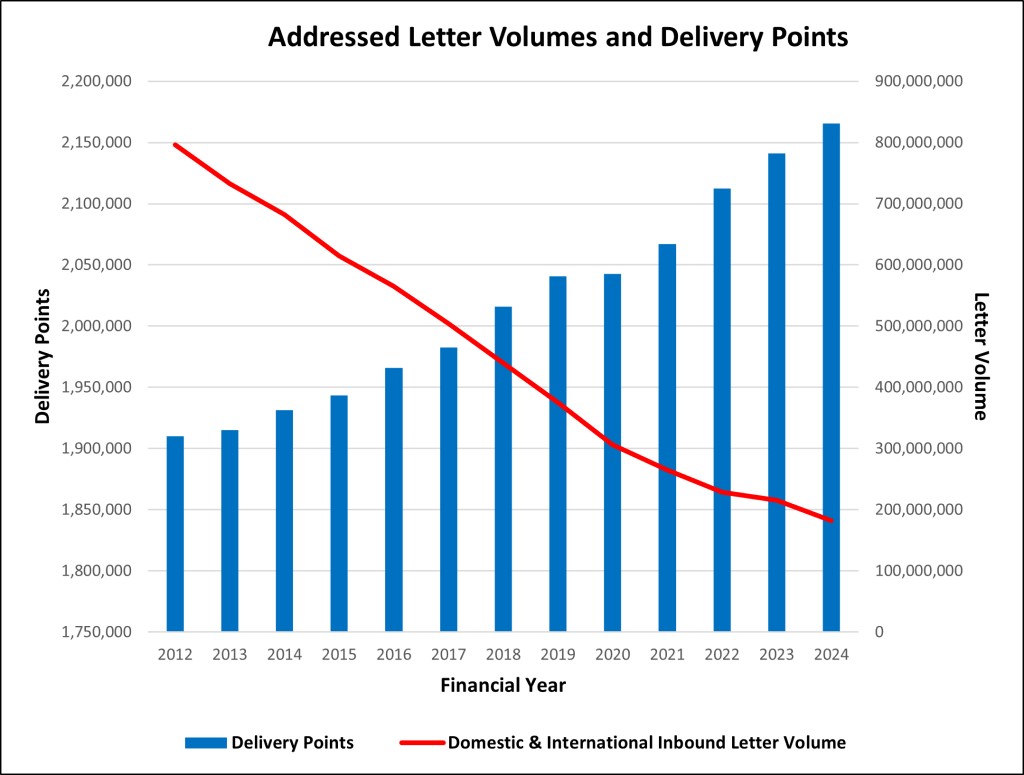Background on mail in New Zealand
This section outlines our current understanding of how New Zealanders use the mail service and how that has changed over time. The section concludes with questions for you on how you use the mail service now and how you intend to use it in the future.
On this page
NZ Post
NZ Post is currently New Zealand’s sole designated postal operator under the Postal Services Act 1998. It supplies postal services both within New Zealand and between New Zealand and other countries. NZ Post became a State-Owned Enterprise in 1987. As a State-Owned Enterprise, NZ Post’s principal objective is to operate as a successful business. This includes being as profitable and efficient as comparable businesses that are not owned by the Crown, being a good employer and exhibiting a sense of social responsibility.
Overview of the Deed of Understanding
The obligations for a nationwide mail network are set out in the Deed, which is an agreement between NZ Post and the Crown. The Deed governs mail delivery frequency, delivery points and NZ Post’s retail presence. It does not set mail prices, as these are set commercially by NZ Post. The Deed of Understanding was first established in 1989. The last substantive changes were made to it in 2013.
In summary, the current Deed mandates that NZ Post has at least 880 retail points of presence, with at least 240 of those being staffed. It sets urban delivery at not less than three days per week and most rural delivery at five days per week. It requires that NZ Post extend its mail delivery network to the extent there is demand, unless it is operationally impracticable or not commercially sustainable to do so. The Deed also prevents the introduction of a rural delivery fee for mail receivers (noting this does not include rural charges on parcel senders).
Universal Postal Service Obligation
New Zealand is a member of the Universal Postal Union, where NZ Post is our representative. As a member of the Universal Postal Union, New Zealand has obligations to have a universal postal service. We have discretion about how we meet those obligations.
The Deed is how we meet our Universal Postal Union obligations for a Universal Service. The Deed sets the requirements of the Universal Service Obligation as they apply to mail carried by NZ Post in New Zealand.
Who is using the mail service
NZ Post data from FY2024 revealed that from the around 182 million mail items carried in New Zealand that year, the majority (approximately 64%) were sent by private businesses or organisations. The public sector sent around 35% of mail, with individuals accounting for less than 1%. This indicates that New Zealanders are generally receivers rather than senders of mail.
We understand that mail is still an important service to many New Zealanders. We also understand that it may be of particular importance to New Zealanders who do not have reliable access to broadband, are at risk of digital exclusion, rural communities and older people.
Despite significant investment in telecommunications infrastructure, rural internet is generally more likely to face capacity constraints and come at a higher cost than urban internet. Therefore, rural communities may be more likely to depend on mail. Although the availability of low earth orbit satellite services has greatly improved rural communities’ broadband options.
We are aware that some people, notably older New Zealanders, are more likely to value and use the mail service. For some the physical delivery of mail creates an important sense of community and security or is easier to use than digital alternatives.
However, data from NZ Post consumer research showed that while 60% of those living rurally said that the mail service had an essential personal connection to them or their family in 2018, this dropped to 44% in 2024. The same 2024 data showed those aged 55+ did not see mail as being much more important than other services such as television, email and mobile phones.
Māori are identified by the Department of Internal Affairs as possibly being more likely to be digitally excluded, and thus possibly more affected by changes to the mail service than non-Māori. We are interested in understanding the importance that receiving or sending mail holds for Māori.
Reasons public and private organisations currently send mail
We understand the main reasons businesses and organisations currently send mail are:
- Demand from customers: businesses may continue to use mail if their customers want to receive information by mail. For instance, customers may want to receive credit or debit cards in the mail as opposed to picking them up physically.
- Ability to contact a broad customer base: organisations that need to contact a broad customer base may determine mail is the best method of communication.
- Availability of address information: a business may send letters to an address without knowing who lives there. Digital communication relies on obtaining access to personal contact details.
- Digital transformation is still underway: organisations may rely on mail while developing a digital alternative, for example, building a bespoke IT system, or a website and app with the necessary capabilities.
- Some public sector organisations currently have a legislative requirement to post information to addresses.
Declining mail volumes and how use of mail has changed
Like many countries overseas, mail use in New Zealand is declining due to social and technological change. Many people are increasingly communicating in other ways, including via phones and online.
Since the last time the Deed was substantially reviewed in 2013 there have been significant improvements to New Zealanders’ access to digital connectivity. Both the Government and the telecommunications sector have invested in the transformation of New Zealand’s telecommunications networks. By the completion of the current Government programmes, more than 99.8% of New Zealanders will have access to improved broadband connectivity.
In New Zealand, the uptake of digital technologies has led to substantial decline in mail. At current volumes, urban areas receive two letters a week on average, and rural areas receive three. The first graph below shows the decreasing number of letters received per person (per capita) and the decreasing amount received over time per delivery point (a letterbox or PO box).

Graph: Average Number of Mail Items Received Per Week. Data in following table
Data table: Average Number of Mail Items Received Per Week

Graph: Addressed Letter Volumes and Delivery Points. Data in following table
Data table: Average Number of Mail Items Received Per Week
Letter volumes delivered domestically have declined from approximately 733 million since 2013 to 182 million in 2024. Notably, there has been growth in the number of delivery points during that time. The graph above shows how delivery points (physical locations, like a letterbox, where you can receive mail) have increased over the past twelve years, while letter volumes (shown by the red line) have decreased. This means that while NZ Post is delivering to more locations than ever, mail volumes continue to decline.
While the country’s population is growing, the letters sent by volume have decreased every year. This shows that even as New Zealand grows, we are using the mail service less and less.
Similar trends are occurring in other countries, with some examples of how those countries are responding set out below.
Responses in other countries experiencing mail decline
Australia: Australia has reviewed Community Service Obligations (CSO) – the Australian Government’s equivalent to the Deed of Understanding. Changes include reducing number of delivery days, developing new pricing pathways and updating the geographic classification for post office outlets.
Denmark: The Danish Government released its national post carrier PostNord from its delivery obligations in early 2024. The country will have no national postal provider but has plans to contract out provision of mail services for blind people and those in remote island communities.
United Kingdom: Royal Mail has repeatedly sought to reduce its six-day service obligation citing rising costs. Royal Mail’s regulator, Ofcom, released a Discussion Document in January 2024 outlining options for reforming the mail service.
Measures undertaken previously to respond to mail decline
There have already been a number of previous changes and interventions made to respond to ongoing mail decline in New Zealand, namely:
- From 2015, following the 2013 Deed Review, delivery days in urban areas were gradually reduced from six to three days a week. Then in 2016, delivery days in rural areas were reduced from six to five days a week.
- In 2020, NZ Post was provided with $130 million (over three years) in government funding so it could continue to meet its mail network obligations in the face of mail decline.
Given that no changes have been made to the Deed since 2013 and that mail volumes continue to drop, the cost to deliver each letter is increasing. The Deed obligations drive a fixed level of cost that then needs to be spread over a declining number of mail items and an increasing number of delivery points. NZ Post cannot recover the costs of maintaining its network through mail price increases alone.
Therefore, there is a need to consider changes to the Deed to ensure it remains fit for purpose. It is our goal to strike the right balance to ensure the mail service is commercially sustainable and reasonably meets the communication needs of New Zealanders.
Questions for organisations and businesses
1. What sector of the economy does your business or organisation operate in?
2. Roughly how many letters does your business or organisation send in a month? And how many do you receive?
3. Are you planning to undertake any programmes to reduce your business’ or organisation’s reliance on mail e.g. transitioning toward digital alternatives. Why/why not?
4. Is there some amount of mail you still need or expect to send even if your business uses alternative communication channels?
Questions for individuals
5. Roughly how many letters do you send in a week?
6. What is your main reason for using the mail service, versus other means of communication e.g. face-to-face, email, online etc.?
7. What types of communications do you regularly receive by mail? For example, bank statements, utility (telephone, electricity) bills, rates bills and hospital notifications.

